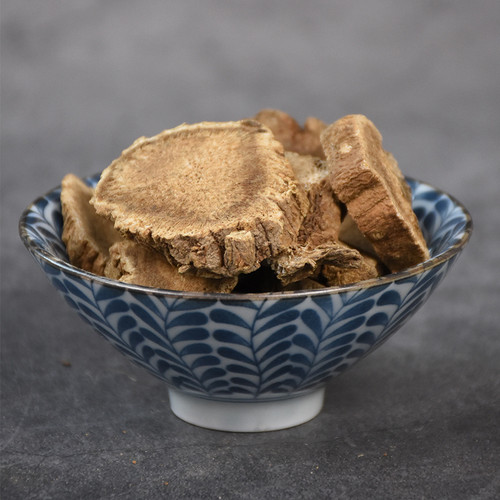Product Overview
Parts used: Dried root
TCM category: Herbs that regulate Qi
TCM nature: Warm
TCM taste(s): BitterPungent
Meridian affinity: Gallbladder Spleen Stomach Large intestine Liver Lung
Scientific name: Saussurea costus, Saussurea lappa, Aucklandia lappa
Other names: Kuth
Use of costus roots (Mu Xiang) in TCM
Please note that you should never self-prescribe TCM ingredients. A TCM ingredient is almost never eaten on its own but as part of a formula containing several ingredients that act together. Please consult a professional TCM practitionner, they will be best able to guide you.
Preparation: Remove impurities, wash, cut in thick slices and dry.
Dosage: 3 - 9 grams
Main actions according to TCM*: Relieves the Stagnation of Qi of the digestion in the Spleen, Stomach and Intestines. Relieves Qi Stagnation of the Liver and Gallbladder. Strengthens the Spleen and is used with tonifying herbs to prevent their potential cloying effects.
Primary conditions or symptoms for which costus roots may be prescribed by TCM doctors*: Abdominal pain Abdominal bloating Vomiting Diarrhea
Contraindications*: This herb should not be used by those with Yin and Blood Deficiency.
Common TCM formulas in which costus roots are used*:
For Qi Stagnation caused by Cold Stomach and Spleen combine costus roots with nutmeg (Rou Dou Kou), crow-dipper rhizomes (Ban Xia) and fresh ginger (Sheng Jiang).
For Cold Stagnation in the Liver meridian associated with hernia combine costus roots with fennel seeds (Xiao Hui Xiang), cinnamon bark (Rou Gui) and dried ginger (Gan Jiang).
For Hot type dysentery combine costus roots with goldthread rhizomes (Huang Lian).
For retching, nausea, diarrhea and abdominal pain due to cold in the Stomach combine costus roots with long peppers (Bi Ba), lesser galangal rhizomes (Gao Liang jiang) and houpu magnolia bark (Hou Pu).
For Diarrhea due to Damp-Cold combine costus roots with sichuan pepper (Hua Jiao), atractylodes rhizomes (Bai Shu) and tangerine peel (Chen Pi).
Key TCM concepts behind costus roots (Mu Xiang)'s properties
In Traditional Chinese Medicine (TCM), costus roots are plants that belong to the 'Herbs that regulate Qi' category. Herbs in this category typically treat a TCM condition called 'Qi Stagnation'. Concretely it means that Qi is blocked in the body's Organs and Meridians, most typically the Stomach, Liver, and to a lesser extent, the Lungs. In modern medicine terms, Qi Stagnation often translates into psychological consequences such as depression, irritability or mood swings. It's also frequently associated with conditions such as premenstrual syndrome (PMS), menopausal symptoms, the development of breast swellings as well as various digestive disorders.
Furthermore costus roots are plants that are Warm in nature. This means that costus roots tend to help people who have too much "cold" in their body, although with less effect than a plant that would be Hot in nature. Balance between Yin and Yang is a key health concept in TCM. Those who have too much cold in their body are said to either have a Yin excess (because Yin is Cold in nature) or a Yang deficiency (Yang is Hot in Nature). Depending on your condition costus roots can help restore a harmonious balance between Yin and Yang.
Costus roots also taste Bitter and Pungent. The so-called "five elements" theory in Chinese Medicine states that the taste of TCM ingredients is a key determinant of their action in the body. Bitter ingredients like costus roots tend to have a cleansing action on the body by clearing heat, drying dampness and promoting elimination via urination or bowel movements. On the other hand Pungent ingredients tend to promote the circulations of Qi and body fluids. That's why for instance someone tends to sweat a lot when they eat spicy/pungent food.
The tastes of ingredients in TCM also determine what organs and meridians they target. As such costus roots are thought to target the Gallbladder, the Spleen, the Stomach, the Large intestine, the Liver and the Lung. Similar to modern medicine, in TCM the Gall Bladder stores and releases bile produced by the Liver. It also controls the emotion of decisiveness. The Spleen on the other hand assists with digestion, blood coagulation and fluid metabolism in the body. The Stomach is responsible for receiving and ripening ingested food and fluids. It is also tasked with descending the digested elements downwards to the Small Intestine. The Large Intestine receives the "impure" parts of the digested food from the Small Intestine, absorbs the remaining fluids and excrete the remainder as feces. The Liver is often referred as the body's "general" because it is in charge of regulating the movements of Qi and body fluids. It also takes a leading role in balancing our emotions. In addition to performing respiration, the Lungs are thought to be a key part of the production chain for Qi and the body fluids that nourish the body.









